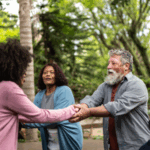Banners flanked the Great Hall of Newcastle University and stories were told each morning to put names and faces to indigenous history and resilience during the Welcome to Country at the 2011 meeting of the Synod of New South Wales and the ACT.
The banners were created by fabric artists in the Hunter region invited to take part in the Reconciliation Art Project, 2011.
The project aimed to “provide a medium through which First Peoples’ understanding of contact history and experience of reconciliation and survival could be expressed”.
The artists met regularly with indigenous men and women to respectfully listen and work together to express their stories with fabric — and it was out of this process the Synod banners were born.
A booklet showing the fruit of the Reconciliation Art Project, 2011, was on sale at the Synod. In its introduction, the Rev. Felicity Amery explained that the project originated from a desire to generate excitement about the Uniting Church’s revised preamble to the constitution adopted at the church’s 12th Assembly meeting in 2009 — and subsequently endorsed by the synods and presbyteries throughout 2010.
The preamble acknowledges the significance place of Aboriginal and Torres Strait Island people prior to non-Indigenous settlement. It tells the truth about the history of Australia, including the truth of her Christian churches, and it places the Aboriginal and Torres Straits Islander people at the centre of the denomination’s life and witness.
Its adoption also challenged the Uniting Church to forge new commitments and partnerships between Indigenous and non-Indigenous Australians.
Mrs Amery said it was hoped that Synod members and readers of the booklet would “take the time to let these stories penetrate our protective layers of denial, indifference and unacknowledged complicity in the pain that has been inflicted on many generations”.
The project had been creating a ripple effect, she said. That often happened when stories were shared respectfully in relationship and people “intentionally sought to view the world through someone else’s eyes”.
Synod members heard on September 24 from Di Langham from Mount Gambier South Australia and of the Boandik people.
Ms Langham said her personal history included her mother being part of the Stolen Generation. Di trained to be a teacher and at the time New South Wales Aboriginal Australians were governed by the Flora and Fauna Act.
In 1967, when Ms Langham was 18, a referendum was held in Australia and an overwhelming majority said “yes” to enable Aboriginal Australians to become citizens of Australia.
Ms Langham is now a chaplain at Cessnock Correctional Centre.
She urged the Uniting Church to support the proposed 2013 referendum to give formal recognition in Australia’s Constitution to Aboriginal and Torres Strait Islanders as the First Peoples of Australia.












